
Ray Arrell, Regen’s Head of Technical Development and member of our internal Net Zero Task Force, summarises our work on looking to tackle our carbon emissions from office energy use.

Ray Arrell, Regen’s Head of Technical Development and member of our internal Net Zero Task Force, summarises our work on looking to tackle our carbon emissions from office energy use.

As part of Regen’s recent commitment to be net zero by 2030, as an organisation we are looking at our various sources of carbon emissions and how we can reduce them. As my colleague Mark Howard explained in his April blog, part of the process to tackle our emissions starts in our office, looking at our direct onsite emissions (scope 1) and our emissions from imported grid electricity (scope 2).
As a small office-based organisation, Regen is a pretty low energy user, consuming 8-10 MWh of electricity and c.25 MWh of gas annually. Our office is spread across two ground floor suites of Bradninch Court in Exeter city centre. A gas boiler supplies central heating to the building, which we pay a proportional share of, and we have two metered electricity supplies for our two spaces. In this blog we will focus on our work to look at options to reduce our electricity use and understand the options available to us to decarbonise our electricity supply.
We are choosing to report our emissions voluntarily and the methodology we opt to go with is fairly flexible. However, as part of embarking on our own journey to net zero, we are challenging ourselves to see what tangible learning we can share.
2020 and 2021 were/are extremely unusual years with almost the whole team working from home for the majority of the time. We will resultantly see a stark difference in our electricity use, compared to 2019. However, with Regen’s socially distanced hot desk policy in full effect, our lighting, IT and kitchen appliance use has begun to creep back up. Plus as a not insignificant proportion of our footprint moving forward, our scope 2 emissions from office electricity use remain an area we need to do something about. Renting a small city-centre office, the main options available to us to address our scope 2 emissions can be summarised as follows, with varying levels of both impact on our emissions and ease of implementation:
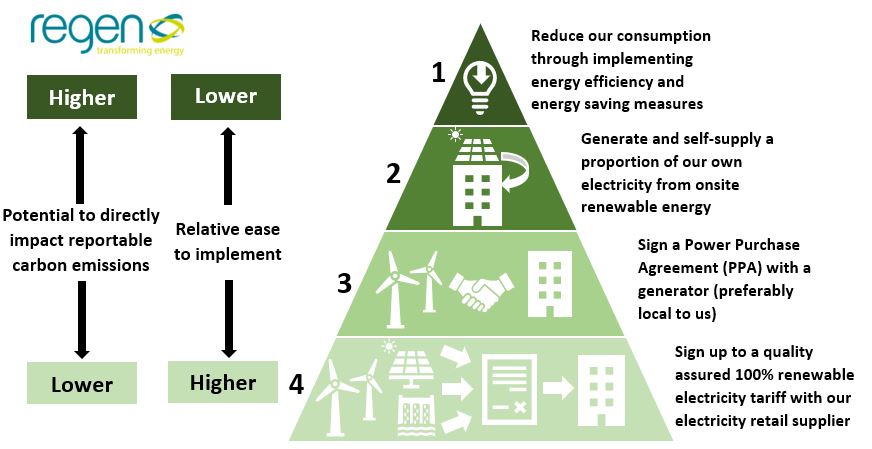
1) Reduce our consumption through implementing energy efficiency and energy saving measures
Regen moved offices a little under three years ago and as part of that process we looked at fitting out our office with energy efficient equipment from the outset. We have decent LED lighting, we put our server in as a small room as possible to minimise air conditioning demand and we considered the efficiency ratings of our kitchen appliances and our IT hardware. We also have made use of simple measures such as reminding staff to turn out the lights and computer screens when not in use. There are always obviously more in-depth things that can be done to reduce office electricity use, such as:
However, there are likely to be diminishing returns on these types of measures and the impact they could have on our overall emissions would potentially be fairly small. So the internal team looking at our carbon reduction is focused on actions that we can implement quickly and effectively. Another part of our footprint we will be tackling is staff commuting to the office, for example. But we will continue to look at and implement energy saving measures where we can moving forward.
2) Generate a proportion of our own electricity from onsite renewables
Described by some as ‘deep green’, if an organisation installs renewable energy generation onsite, in a configuration that directly supplies electricity to meet onsite demand (known as ‘behind the meter’ or via private wire), it will reduce the amount of imported grid electricity. This therefore enables an absolute reduction in scope 2 emissions for that business, due to the onsite generation reducing reportable metered grid imports. Being based in the middle of Exeter, there is no practical potential for a small wind turbine, so the main option for us would probably be rooftop solar PV. Regen both rents and shares office space in a Grade II listed building, so the potential for rooftop solar is not a straightforward option and is something we will need to revisit with our landlords and the other tenants of the building and is unlikely to be a priority area for 2021.
3) Sign a Power Purchase Agreement (PPA) with a generator
An alternative method to source renewable energy into the business is to sign a contract to purchase it as a commodity, where renewable energy is not directly supplied to site via a private wire or behind-the-meter. One way of doing this is to sign a power purchase agreement (PPA) with a generator, whilst also involving your electricity supplier (to a lesser or greater degree). There are a few types of PPA out there, some examples of which are highlighted below:

For a company the size of Regen, these types of contractual arrangements are unlikely to naturally fit with us and our low annual consumption, equally we are not an overly attractive PPA offtaker proposition for renewable energy generators. Therefore, whilst something we may consider further, (including the principle of a consortium arrangement to join a ‘sleeving pool’ PPA such as the one we exploring with Bristol City Council), a more traditional green tariff may be a more suitable option for us to pursue at this time.
4) Sign up to a genuine 100% renewable electricity tariff with our supplier
A relatively simple action we have already taken as a business electricity consumer is to sign up to a green retail supply tariff – something many organisations and households have done. As my colleague Johnny Gowdy highlighted in a previous blog, the authenticity or genuine ‘greenness’ of some retail electricity tariffs available on the market isn’t as straightforward as it may seem. This is a live topic, with some green energy suppliers themselves highlighting the issue of ‘greenwashing’[1] [2].
Uswitch now also provide a rating of green tariffs on the market, scoring how legitimately green the tariff is using a bronze/silver/gold accreditation. The value of this accreditation scheme is still to be determined however, as this scrutinises individual tariffs rather than the providing supplier and as a voluntary scheme it is likely not to engage all suppliers on the market and so not provide a complete picture.
HM Treasury recently also announced the creation of a new independent group to tackle greenwashing to ensure the growth of a genuine ‘green taxonomy’ in the UK.
So the awareness of the issue of greenwashing has increased in recent years, but more work needs to be done to make clear what consumers are signing up to and what generation technology mix actually sits behind the tariff from their retail supplier.
Regen has sought to try and avoid the pitfalls of greenwashing and signed up to a genuine green tariff that is backed by actual purchased renewable energy. However, when reviewing electricity use as part of our carbon emissions, a question is raised: does signing up to a genuine green tariff materially affect our reportable scope 2 carbon emissions? I’m afraid to say the answer to that question is not as straightforward as you would think and boils down to a number of fairly specific factors:
Taking each of these in-turn, firstly an organisation’s carbon emissions can be reported under two different methods under the GHG protocol and within each of these methods, emissions from imported electricity can be deducted from either (or both) net and gross total emissions.
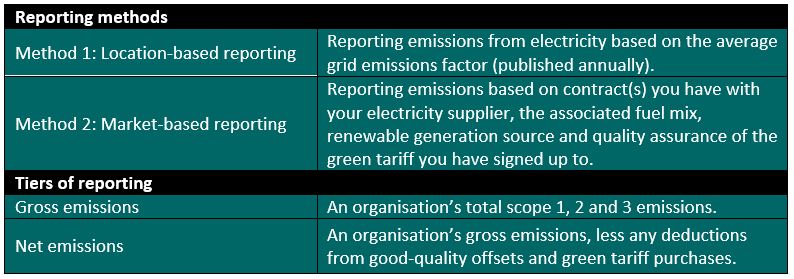
For our 2019 assessment and our 2020 footprinting, when we had a different energy supplier, we followed method 1 and reported gross emissions of around 3.5 tCO2e from our electricity consumption. Revisiting this issue this year, with our 100% renewable backed ‘Green Electricity’ tariff, we have been investigating how this may affect our scope 2 emissions moving forward under both reporting options.
If we were a larger organisation, as a minimum we would have to report our location-based scope 2 emissions, but we have the choice to also report these emissions through the market-based method. So considering our green tariff, the decision process and outcomes might look like this:
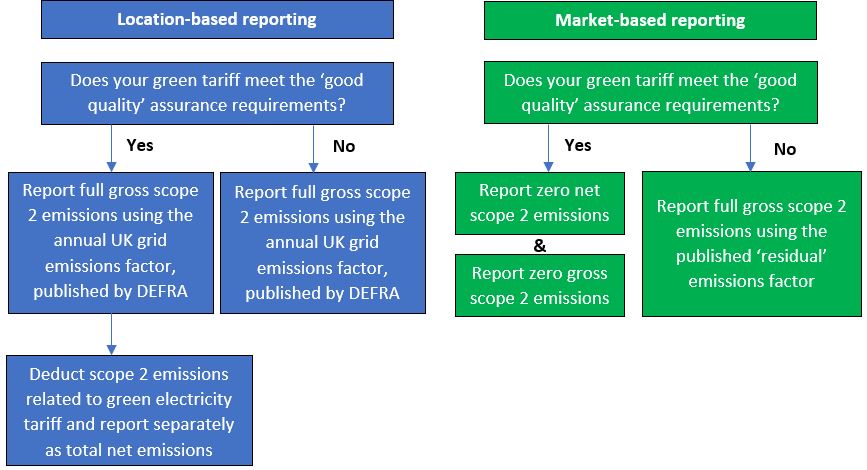
As described in our 2018 blog, REGO certificates are intended to be the underlying instrument that evidences that a MWh of energy generated, supplied or bought comes from a genuine renewable energy source. There have been distortions in the supply market with the creation of surplus REGOs that can be traded via a secondary market, this is partially due to the fact that the UK electricity market allows the energy volume and the associated REGO certification to be ‘unbundled’ and thus possibly sold/purchased separately. This has resultantly given rise to a false labelling or greenwashing of some tariffs to customers. Our graphic from 2018 remains a good summary for how REGOs can be used to artificially greenwash non-renewable electricity:
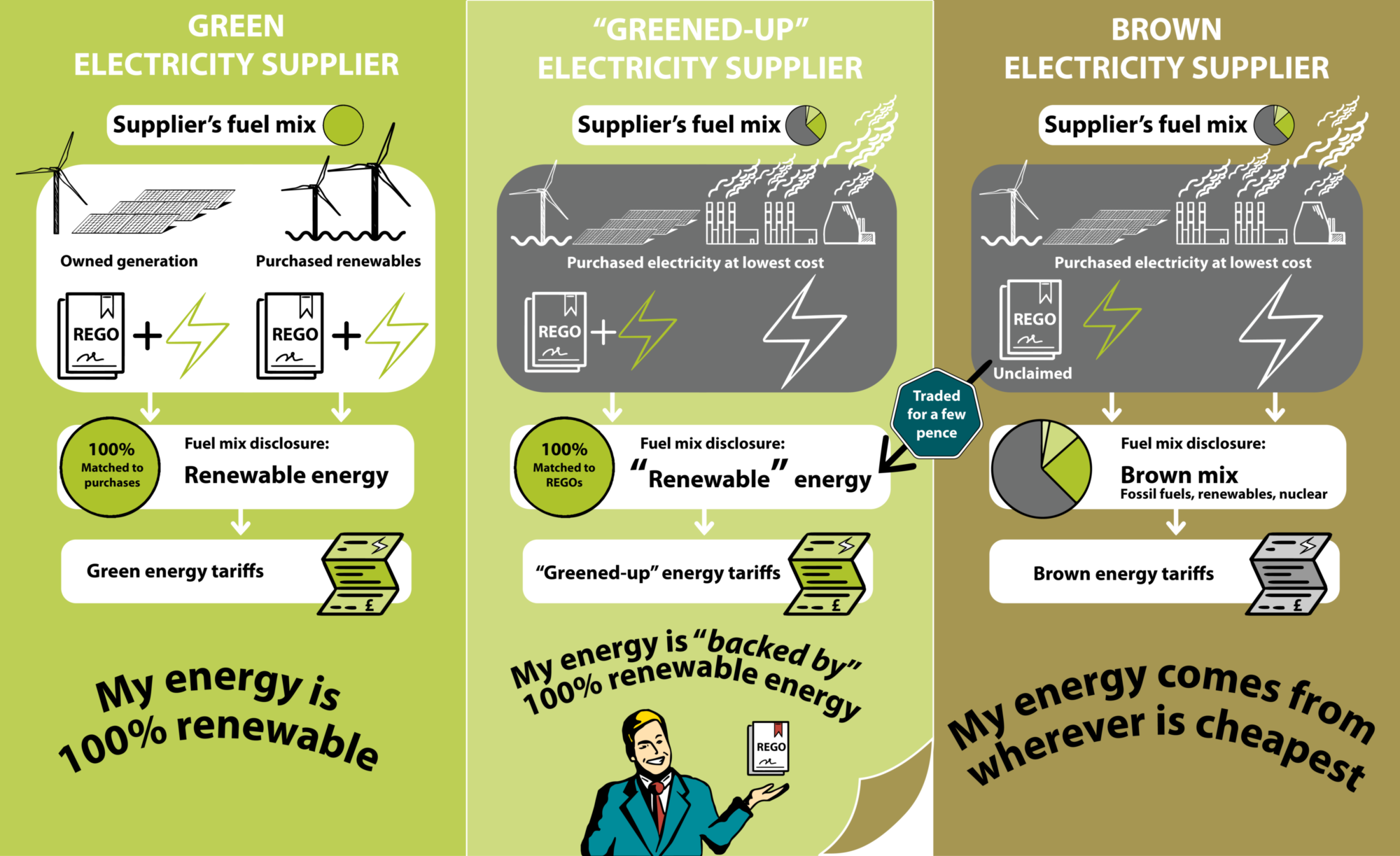
If the tariff falls into the left-hand block, a genuinely 100% renewable tariff, for carbon accounting purposes the GHG protocol guidance suggests that they need to meet three quality assurance criteria (reference, credit and source: UKGBC guidance):
Unpicking this with our own supplier, our interpretation is that the tariff we have signed up to meets these three ‘good quality’ requirements, specifically:
However, determining whether a green tariff genuinely meets these criteria is not straightforward. Some suppliers who perpetuate greenwashing (i.e. buying fossil-fuel energy, buying the equivalent amount of REGOs and greening up their supply), can present a potentially misleading view of the actual energy they have bought, through information such as fuel mix disclosures. The transparency of green tariff legitimacy remains an issue for the sector and should be one we keep talking about and Regen has been calling for far greater transparency and a reform of the system of fuel mix disclosure.
With the intricacies of reporting and greenwashing traps aside, a wider consideration is that by signing up to a genuine green tariff at home or at work you are sending a signal to your supplier that you would like them to go and buy more electricity from a renewable energy generator. You could compare this to the purchasing of genuine free range eggs or fair trade coffee, where your consumer power is sending a ‘please source another one of those’ message to the supermarket and their own suppliers. It goes without saying that the electricity market is very different to food supply and the power of consumer actions is potentially diluted by the structure of the electricity system and markets. However, by signing up to a green tariff that definitively meets the standards of being genuinely renewable generator sourced, guaranteed/certified origin and promoting additionality, this can still be seen as a positive signal to the market.
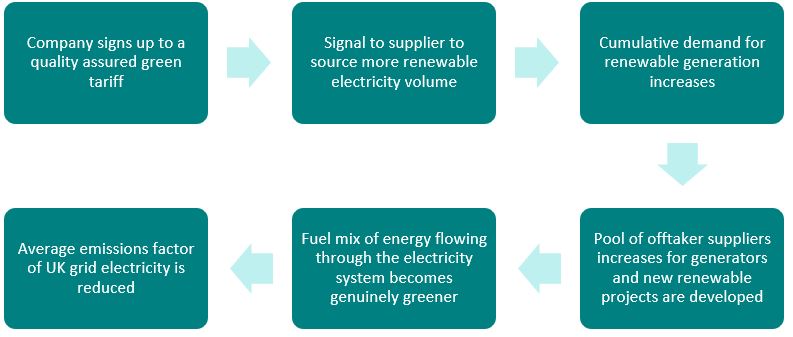
In conclusion, considering the options for reducing our scope 2 emissions has revealed the some of the complexities of carbon reporting and how some of the nuances of the electricity retail market can distort what is a truly green electricity supply. In the hierarchy of high level options open to us, reducing our use or generating it onsite will always win out as the most directly effective action we can take as an organisation to reduce our emissions from onsite energy. However, the potential for genuine, quality assured, renewable generation sourced green tariffs and renewable PPAs to have a material effect on our reportable emissions is also something that should be considered, scrutinised and probably talked about more.
With Regen joining an ever-increasing number of companies in the race-to-zero, we would be interested in joining the collective conversation about the role and value of green tariffs.
We’d welcome views from our members and other companies diving in to this area as well.
As discussed above, our offices are heated by a communal gas boiler, not by electricity fuelled technologies. Therefore when considering our green energy supply and scope 1 emissions, we need to consider our portion of the building’s gas consumption as well as the electricity used in lighting and appliances. How we are aiming to tackle our scope 1 emissions from gas fuelled heating will be the subject of a further blog!
Author: Ray Arrell, Head of Technical Development (rarrell@regen.co.uk)
[1] Good Energy – https://www.goodenergy.co.uk/greenwash/
[2] Ecotricity – https://www.ecotricity.co.uk/our-green-energy/greenwashing
[3] Based on Regen’s high-level interpretations of the GHG protocol and Defra guidance
[4] See REGO explanatory memorandum, UK Government: https://www.legislation.gov.uk/nisr/2010/374/pdfs/nisrem_20100374_en.pdf